While the common, everyday occurrences that surrounded the war were not unique to most small towns, the presence of enemy prisoner of war camps in the local area was.
| WHO WERE THEY AND WHERE WERE THEY HELD? |
| The Pend Oreille Valley would serve as host to both German and Italian prisoners for the duration of the war, housing them at old Civilian Conservation Corps (CCC) camps or in the case of the largest contingent of prisoners, right outside the gates of Farragut Naval Training Station. Many of the prisoners that were brought before 1945 were considered detainees, crews of merchant vessels or U-Boat crews captured in South America or off the East Coast at the beginning of the war. However, in February 1945, 750 German and Austrian North Afrika Corps troops and some U-Boat crews were brought to Camp Farragut, an enclosure across the road from the training station. |
| THE FOUR CORNERS CAMP |
| The Italians and later the Germans designated as "detainees" rather than prisoners of war were held at this CCC Camp in the Kaniksu National Forest. The camp as shown on the map below by a small black square (circled in red) was located at what was traditionally known as the Four Corners area. This location on this US Forest Service map of 1942 is not labeled Four Corners, however in 1943 when they were brought from Fort Missoula, Montana they were placed in CCC Camp #F-164, near the Falls Ranger Station at what had been and is now called Four Corners. |
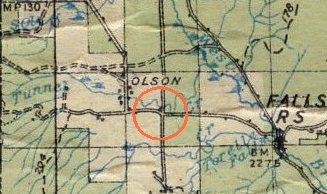 |
The Four Corners Camp
SW 1/4 NW 1/4 Sec17 T57N R5W (Boise Meridian)
Kaniksu National Forest, US Forest Service
Idaho, Montana, and Washington, Polyconic Projection, 1942 |
| In 1944, German "detainees" were brought into the Four Corners camp but were then moved to vacated Veteran's (World War I) CCC Camp in Usk, where they would remain until 1945 when they were sent back to Fort Bismark, North Dakota and other camps. Previously veterans of World War I working for the Civilian Conservation Corps had been housed at the camp which was located one-half mile from the railroad stop in Usk. Its location on this 1942 Forest Service map (below) is labeled as F-103 and is circled in red. |
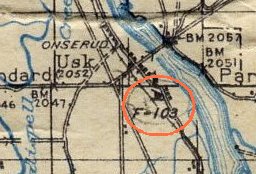 |
Camp F-103, Veteran's CCC Camp
SW 1/4 Sec32 T57N R44E
Kaniksu National Forest, US Forest Service
Idaho, Montana, and Washington, Polyconic Projection, 1942 |
| The German and Austrian prisoners held at Camp Farragut arrived there in 1945, and for the most part were U-Boat crews and Afrika Corps members. The 750 prisoners brought in 1945 were sent to Farragut once the cotton harvest in the South and the Southwest were over, and all were designated as "trustees," those that professed that they were anti-Nazi and pledged that they would not try to escape. |
| UNDER WHAT CONDITIONS WERE THEY HELD? |
| Regardless of whether they were designated as detainees or prisoners of war, they were all held in regards to the Geneva Conventions. This meant that they had to be given living conditions and food that was similar to what soldiers in the United States military were getting, and if they were to be put to work it could not be war related. |
| DID THEY WORK? |
| Those that were placed in CCC camps at the Veteran's Camp in Usk, and Camp F-164 near the Falls Ranger Station above Priest River,and to some extent Camp Farragut, were put to work doing the tasks that the CCC boys abandoned when they went to war. German and Italian prisoners worked doing brush disposal, building and cleaning trails, white pine blister rust control, and on the fire crews during the summer. Some were even offered to help in some of the agricultural work, something that prisoners were already doing in the camps in the South and the Southwest, as well as in Montana. Those that were held at Farragut were also allowed to work inside the Naval Training Station as groundskeepers, but all were paid wages so that they could purchase what they needed from the local communities. The wages paid were commonly in the form of canteen coupons, especially in the larger camps. |
| WERE THERE EVER ANY ESCAPES? |
| As these prisoners were held in such remote locations, very few attempted escape, even when taken out into the communities. There were some that tried to escape in the South and the Southwest, where there were larger camps, but for the most part, the remote location of the camps in the Pend Oreille Valley and the fact that these men were given such favorable living and eating conditions, many were content to stay where they were until the war was over. |
| Bob Rednour: But these prisoners weren't really prisoners, they were just, well they were taken as prisoners, but they I think enjoyed themselves. It was getting in on the American way of life and they were, they didn't have to fight anymore just they were here to enjoy themselves and do their job. |
| CONTACT WITH THE LOCAL COMMUNITIES |
| Residents of the Pend Oreille Valley especially remember the Germans being brought into Newport twice a week for liberty and to purchase things like cigarettes and the other essentials of life for a prisoner, or to sit around the streets of Newport, enjoying their time out of camp. |
Norma Rednour worked at Kimmel's Drug Store, and remembers the German prisoners the most:We took the good cigarettes, the Camels, the Lucky Strikes, and some of the others, and we put them underneath the counters, and we would give them the cheaper brands [laughs] the Pal Malls, I don't remember the name of some of the others, but and they would buy those. They would sit up at the soda fountain and talk. ... they would make comments in German as we went past them on the street down to the Post Office, and they would be standing there, sitting on the Northern Hotel steps and standing out on the edge and so you had to go through the middle of them...disconcerting. |
| Bob Rednour recalls the German prisoners at the Usk Camp: I know the Germans were there then because the people that was on McClarity's place there see Dan and old Jack McClarity owned the place that the Paper Mill is on now and uh they owned the land down by the river and they had a fella that was staying there and he put in about pert near 5 acres of potatoes and he had a couple daughters and the Germans, these daughters had the Germans over there in the shade of the house. |
| Pat Geaudreau Just knew the Italians were up here, but I really didn't know that much about the camps we'd just see them on the weekends they'd bring 'em into town, into Newport, and I didn't try to talk to 'em because they didn't know English and so it was just a case of you know, you'd see 'em on the street 'cause everybody walked up and down Main Street. |
| Evelyn Reed's father was the operations manager for the Kaniksu Forest, and as such ordered all the supplies for the camps. Evelyn recalls her father having Camp F-164 as one that he got supplies for, and that the Italian prisoners would often make things for children of Forest Service employees: But if some of them were cooking and so on and they used to make some fabulous meals, especially this crew and then a lot of them were family people and they used to send us little gifts and stuff. I can remember, oh like one of them made me some jewelry out of nutshells that were painted and stuff, you know and strung on elastic bands and things like that. That was in the earlier parts of the war, when I was a little younger, but in fact I think even at the time I got it, it was probably kinda young for me but anyway. But they were pretty much, these guys were people that volunteered to do this, rather than just sit it out in whatever they were in, so it was kind of like trustees or something I guess. |
| Evelyn also recalled them being brought into Newport: They used to bring the truckloads, busses, I don't remember I think they were open trucks that they brought into town periodically for some kind of a recreation thing and that wasn't always too popular with the local people. |
| Bill Piper also recalled them being brought to Newport and Oldtown: Oldtown was one of their favorite spots because of the beer joints. They'd bring 'em down in trucks and drop 'em off to have a good time. They coulda walked away if they wanted too. That's what I noticed mostly, they were very happy, they didn't want to go back to the war, they knew it would be over eventually and they could go home. |
| Henry Rahder remembers those that were kept at Fort Missoula, Montana and how they used to come and work on his father's farm, and the contact that they had with the local community where he lived: Now Fort Missoula was not a military post during World War II, it was a detention center for primarily Japanese, Italian, German sailors who got caught in American ports when the war started. They were not in any way military and they were housed over there at Fort Missoula and which was only a mile, mile and a half away from our place and they would actually come out and scavenge on some of the farms, like our farm. We had a big orchard there which was no longer an effective orchard really in a sense but we had apples, they'd come out and pick apples for their own use and they would come out with a crew it was interesting because the crews that came out they were the Japanese and people thought my mother was foolish because they couldn't speak much English and she sure couldn't speak much Japanese and she basically would back out and let them come into the kitchen and cook their own meals, but we didn't have any problems with them. But many of the Italian and German prisoners became acquainted with American women from Missoula and there were a number of marriages that occurred after the war. A number of them did wind up staying. If a crew came out to work on one of the farms a guard came with them. That guard was pretty relaxed about the whole thing. |
| CAMP RECREATION |
| The prisoners did not just enjoy recreation outside of the camp gates, but they were offered a number of recreational activities inside the camp as well. Prisoners often had some sort of a camp library (especially in larger camps), football (soccer) fields, musical instruments that were in some cases used to develop camp orchestras or bands, handicraft materials, as well as the ability to take academic courses and create camp newspapers. |
| WHAT DO THE CAMPS LOOK LIKE NOW? |
| Today the camps that held German and Italian detainees or prisoners have grown up with weeds, and in the case of the Usk F-103 Camp, businesses and homes. The Four Corners camp and Camp Farragut can only be found on maps, and the camp at Usk has become part of the Pend Oreille Valley Railroad complex with a few scattered homes around it. |
| Bob Rednour: Well they tore the big buildings down. When you go in, just before you get to the railroad, there was a road that went straight back and there was a big houses and stuff on the south side of that road and then on the north side there, a couple of barracks there, and then they had all like the ones that Nelson's, Diesen's, and McGill's there was several of them around that some of the officers and stuff lived in and then just up from Bud Carsten's they had a building there and uh they uh the state took it over later as a office for the Department of Natural Resources. |
| The pictures below show what the Usk F-103 camp looks like now. |
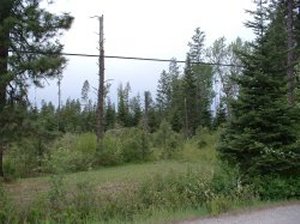 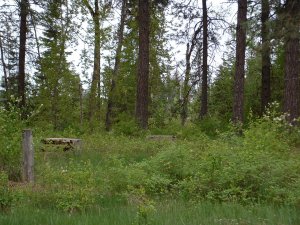 |
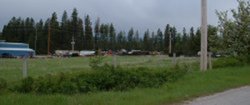 |
| The present-day site of the Veteran's CCC Camp in Usk where German and Italian prisoners of war were held |
| Regardless of whether they were prisoners of war or detainees, the German and Italian prisoners often had it better than their counterparts held in Germany. Despite the fact that approximately 980 German and Italian prisoners of war were brought into the Pend Oreille Valley during the course of the war, nothing had been mentioned of them, except by those that lived here throughout the war, remembering them simply as nice young men that for the most part kept to themselves. |




